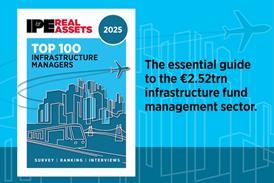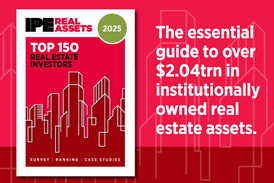The way in which German open-ended real estate funds are valued is under scrutiny, but is there a case to answer? Sally Hodge reports
In his recent paper ‘German Open Ended Funds: Was there a Valuation Problem?' professor Neil Crosby of the University of Reading Business School addresses many of these questions. Crosby is adamant that, despite the increasing level of noise, there is still no direct evidence that Germany has a case to answer. "Whatever the perceptions and prejudices, nothing is proven - there is only circumstantial evidence," he says. Crosby does, however, believe that there remain some questions that do need answers.
According to Crosby, the fact that the German property market has continued to produce such stable returns over a long period, when the volatility of world property markets has been pronounced, is a major reason to ask questions. Indeed, Crosby looked at data from IPD to examine the annual volatility of the German office markets from 1989 to 2005. German annual volatility over this period was 2.45%, compared to 9.24% for the US, 9.42% for Canada, 9.43% for France, 9.8% for the UK and 13.27% for Sweden. Even the Netherlands, at 5%, was over double the volatility of Germany.
"There is disbelief around the world that any property market can be so stable," Crosby comments. "If the smooth volatility curve in German markets is the catalyst for the increasing questions, what is the reason behind this German stability? There is little doubt that, if the objective of German open-ended real estate funds is to avoid the fluctuations of the property market to which most countries are accustomed, they have succeeded. Indeed, Crosby's paper cites statements from a Bundesverband Investment und Asset Management e.V. (BVI) marketing document, such as ‘a low volatility alternative', ‘steady growth in value at a low risk', and ‘stable profitability and the absence of wrenching moves in market prices'. "Somehow," says Crosby, "the numbers fit the policy".
With such low volatility figures matching the funds' underlying objectives, scepticism about what underpins these numbers was almost bound to grow in momentum. How has such a smooth curve been possible? Crosby suggests that there are two basic methods that could have produced these numbers. "They could have discovered the holy grail of diversification of portfolios," he says. The alternative is, he suggests, that the true level of volatility is being hidden.
Although there is no conclusive evidence of the fact that property market volatility in Germany should be higher than reported, taking the premise that it is unlikely to be as low as reported, Crosby discusses how the true volatility in the performance measures could be hidden using valuations. Firstly, he points to the fact that German fund prices are valuation and not transaction based; and secondly, to the possibility of client influence over German valuers.
Crosby believes that this view that performance stability is important is a perfect fit with the overall German view that a stable economy creates stable returns.
In Crosby's opinion, however, "it is absolutely wrong to say that German valuers use sustainable long-term value as the basis on which to value." In his paper, he states: "the basis of valuation is not formally ‘sustainable value' as defined within mortgage lending, but is based on market value definitions." However, the definitive evidence of this fact is hard to find. "There have been loads of valuation accuracy studies using IPD data on how close valuations are to subsequent sale prices," says Crosby. "Ironically, German valuations are no worse than any other country in Europe. If prices are a random distribution and valuations are also a random distribution, some high valuations will be attached to low prices and vice versa, meaning that they ought to cancel each other out, even with a perfect market," he notes. The reality of the situation is, Crosby believes, somewhat different.
One of the major reasons for a fund to sell one of its properties will be to meet a need for liquidity. So if liquidity is required, which of the properties in its portfolios will a fund choose to sell? The law of averages suggests that, in a fund anywhere in the world holding 10 properties, some of the 10 will be under-valued and others over-valued. With a need for cash, the over-valued proportion of the portfolio would not be the logical first choice for sale.
In Germany, this logic is added to by the fact that the rules governing German open-ended funds prohibit selling any asset at less than 97% of book value. Hence an over-valued property, which is likely to fetch a lower market price than its valuation suggests, is not simply unlikely to be on the for sale list, but in fact cannot be sold.
Consequently, the fund sells a more conservatively or under-valued property, leaving the portfolio of nine properties probably consisting of a lower proportion of conservatively-valued properties and a higher number of higher, or over-valued assets.
And so to client influence. According to Crosby, client influence over valuers has been proven to exist pretty much all around the world. Indeed, there should be little wonder that real estate fund managers - the clients of valuers - display great interest in the actual valuations placed on the properties they hold. Crosby cites the 2000 study carried out for the RICS and Investment Property Forum: ‘The influence of valuers and valuations on the workings of the commercial property investment market', which identified a number of issues connected to the concentration of valuations in a small number of firms and the relationship between valuer and client in the UK market.
Several reasons why a manager would seek to move a valuation - either up or down - were indentified, including pressure to reduce a valuation to facilitate a later sale of a property. The performance bonuses paid to managers were also an influencing factor on valuers being asked to move valuations up to permit bonus targets to be met. The subsequent UK regulatory changes concerning conflicts of interest, rotation of valuers and record keeping in draft valuation meetings responded to the findings, increased transparency and answered the objectivity agenda.
"In the UK, if you do more than 5% of your work for one client, it can be seen as a conflict of interest," says Crosby. He contrasts this with the situation in Germany where a valuer can carry out up to a third of their valuation work for one entity. In addition, two funds from within the same stable are viewed as separate entities, meaning that a valuer could be dependent on one client for well over 50% of their valuation work.
This is not necessarily a recipe for disaster, and certainly there has been no research on client influence over valuers in Germany, but this is a scenario where, if client influence were to be exerted, a favourable outcome for the client would seem probable.
The transparency that exists within the UK valuation process offers a degree of protection for valuers and investors over client influence on valuations. Valuers' initial valuations are discussed at a draft valuation meeting between the valuer and the client. This process does not eliminate the probability that many clients want to have a say in the final valuation. "About 50% of the valuations are moved up after that meeting," says Crosby. What the meeting does enable to occur, however, is for every change in initial valuations at that draft meeting to be reported on, which, in Crosby's view, gives a strong level of protection to the valuers.
The other key point that Crosby stresses is the availability of information. Valuers are, to a certain extent, dependent on information from a property's owners - their client - about the property they are valuing. If a client chooses not to share specific information, it can influence the valuation. Clearly, the question of the wholeness or partiality of information shared is not limited to any one country, however Crosby believes that UK valuers, who are often also agencies, are closer to the market than their - often smaller - German counterparts. Hence he sees UK valuers as more likely to have increased sources of information to add to the direct information flow from their clients and on which to base their valuations.
"The UK market has had 10 years of the whole valuation process being examined on the back of various moral hazards," says Crosby, and the question now being asked is whether Germany needs to apply a microscope to its own valuation process.
Does Germany have a case to answer? Paul Kennedy, head of research, Invesco Real Estate cautions that we must first ensure that we are comparing like with like. "In Germany, we use the term valuation to mean a different thing from in the UK," he says. Kennedy describes the German approach to valuations as an assessment of worth rather than the actual price that could be obtained for a property were it to be put on the market now.
In the UK, however, Kennedy says that the same term - valuation - is taken to mean what a property can be sold for. So if the valuation of a German property inherently means something different from a UK property's valuation, is there necessarily a problem with the German valuation model? "There is a sense in which German valuers are trying to give you a normative concept; that they are looking at what a property should be worth," Kennedy adds.
The methodology used by German valuers is, he believes, also linked. "What valuers tend to do is, if rents fall, they take a view of whether the fall has been excessive, which truncates the valuation and leads to a smoothing of valuations," Kennedy says. "It is not a case of right or wrong," he comments, "simply of things being different".
And what about the potential for client influence in Germany? Crosby says client influence over valuers is certainly not limited to one country or region and Kennedy agrees that, to a certain extent, it occurs in all markets. However Kennedy does not believe there is any more client influence in the German market than elsewhere. "Germany has a very professional and often maligned real estate market," Kennedy says.
"It has its quirks, but they are quirks of definition rather than of practice," he adds. Where Kennedy is in agreement with Crosby is over the issue of the limited number of clients that German valuers may be reliant on. "The issue of the concentration of work is a valid one," he says. "We run seven funds and in Germany one valuer could value all seven funds: that is a challenge." That said, however, he describes the German valuers that he has dealt with as "predominantly professional".
Kennedy believes that the increasing number of questions being asked about the German property market could easily stem from the fact that these UK questioners are judging the German market by their own standards. "I feel very strongly that the German market is easy to mine," Kennedy says. "We are assuming that because it is different, it is not as good, and that is unfair," he says.
Kennedy's belief in the German market as an attractive market for real estate investors gives a strong hint as to why there are so many questions currently being asked about Germany. "What has happened is that the restrictions on German funds being allowed to invest outside of Germany have been relaxed; and they have the ability to do this via commingled vehicles," says Kennedy. "This has led to sales of German assets, and at the same time the German economy is growing, and yields outside Germany have fallen. So Germany is a more attractive destination."
Whereas German managers who have been invested wholly in German property have remained comfortable that the German valuation system has allowed them to compare like with like, a UK, US or Dutch manager adding German property to their fund may look at the smooth German volatility curve and begin to ask: why the difference? It is likely to be this increasingly diverse mix of investors buying into German real estate that will lead inexorably to a change in the German valuation process, whether or not one is truly required.












